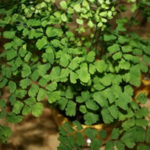Decorate Your Home with Houseplants
One of the great things about growing houseplants is how good they make your home look. With their wide variety of leaf shapes, sizes, colors and textures, houseplants can be used to decorate just about any interior, and they serve a wide variety of design purposes.
Matching Decor
Visiting your local nursery for houseplants is a lot like browsing through wall-covering and upholstery samples. The choices are nearly limitless. Besides flowering plants like African violets, many houseplants have colorful foliage. The velvety leaves of coleus, for instance, come in a variety of colors that can be matched with home décor, including red, green, white and pink.
Ensure a good match with your home décor by taking fabric samples and paint chips with you to the nursery.



(All photos this row and yellow pot below, Steve Asbell, Plant by Numbers)
Make Rooms Look Larger/Smaller
Houseplants can make a small room look larger. A ceiling appears higher when you put a tall, thin plant in the corner of the room, such as Dracaena marginata. You can also make large rooms look smaller. Accomplish this by bringing in a plant that is oversized for the space, which will make the ceiling feel lower, or choose a plant that grows up and then drapes, like the ponytail plant (Nolina recurvata).
Solve Design Dilemmas
Fill in dead corners with houseplants like the tall, bushy Ficus benjamina. When floor space is limited, try hanging houseplants for the same effect. Plants can also be used to break up large living spaces and create transitions between rooms. Use a large palm to separate an entryway from a living room.
Create Focal Points
Houseplants, especially those that bloom, add to a room’s décor when placed in the spotlight. Rather than decorating your dining room table with short-lived cut flowers, try begonias, anthuriums or plants with colorful, variegated foliage like the peacock plant.
Other good spots for eye-catching plants are coffee tables, the foot or top of stairs, kitchen counters and fireplace mantels.


(Julie Bawden-Davis, Healthy Houseplants.com)
Tie a Space Together
Plants can be used to create intimate spaces. Flank a sofa with flowering plants and on the coffee table add a plant with a similar color, and the whole space will feel cozy.
Create Groupings
Clusters of small plants add a decorative touch to certain areas of the home, such as on desks or nightstands and in bathrooms next to sinks or on bathtub decks. They can be placed in individual decorative pots or grouped together in a basket or larger pot. When grouping plants in a larger container, leave each plant in its own container and camouflage with moss.
Groupings look especially good if there is a combination of flowering and foliage plants. If you’re doing all foliage, choose plants with leaf colors that blend well. Herbs are a good choice for the kitchen.
Decorate Containers
Except for hanging plants, pots are a highly visible part of designing with houseplants. Make sure that the houseplant container color, design, shape, size and texture match the room décor and contribute to the atmosphere you’re trying to create. Use excess wallpaper and paint to decorate pots.
Consider Plant Styles
The plants you choose will dictate the feeling of each room. Some plants, like ivy and orchids, lend an elegant atmosphere, while others, like corn plant (Dracaeana fragrans) and spider plant, are more informal.
Pay careful attention to the size, weight, texture and shape of each plant and determine if it will help open up a space or make it more intimate. You’ll want heavier looking plants in a den, for instance, but a bathroom often calls for something lighter.
Pay Attention to Lighting
A room with bright light may wash out the colors in a plant, whereas the same plant may look rich and vibrant in more subdued lighting.





